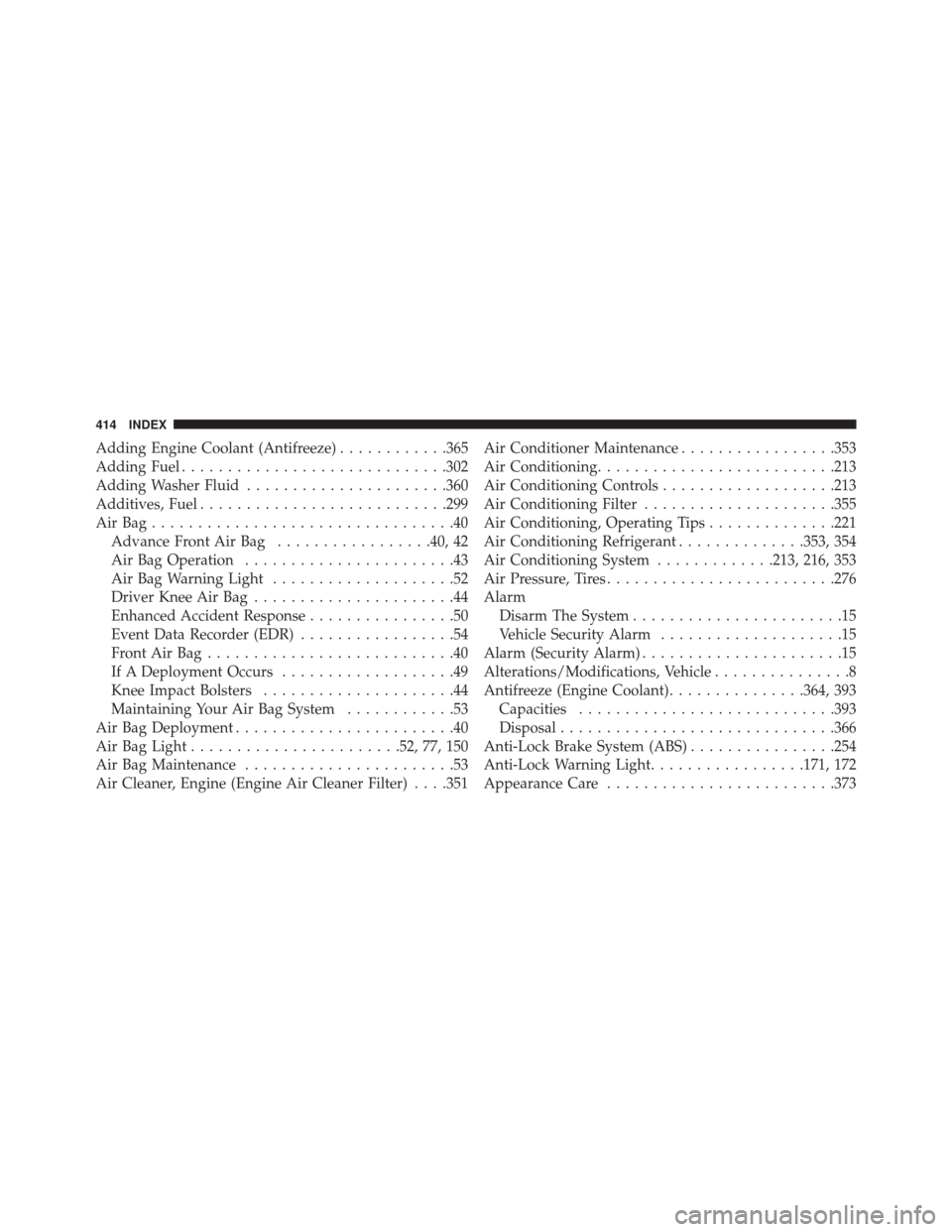Page 277 of 432

WARNING!(Continued)
•Unequal tire pressures from one side of the vehicle
to the other can cause the vehicle to drift to the
right or left.
• Always drive with each tire inflated to the recom-
mended cold tire inflation pressure.
Both under-inflation and over-inflation affect the stability
of the vehicle and can produce a feeling of sluggish
response or over responsiveness in the steering.
NOTE:
• Unequal tire pressures from side to side may cause
erratic and unpredictable steering response.
• Unequal tire pressure from side to side may cause the
vehicle to drift left or right.
Fuel Economy
Underinflated tires will increase tire rolling resistance
resulting in higher fuel consumption.
Tread Wear
Improper cold tire inflation pressures can cause abnor-
mal wear patterns and reduced tread life, resulting in the
need for earlier tire replacement.
Ride Comfort And Vehicle Stability
Proper tire inflation contributes to a comfortable ride.
Over-inflation produces a jarring and uncomfortable
ride.
5
STARTING AND OPERATING 275
Page 292 of 432

CAUTION!
•The TPMS has been optimized for the original
equipment tires and wheels. TPMS pressures and
warnings have been established for the tire size
equipped on your vehicle. Undesirable system op-
eration or sensor damage may result when using
replacement equipment that is not of the same size,
type, and/or style. Aftermarket wheels can cause
sensor damage. Using aftermarket tire sealants may
cause the Tire Pressure Monitoring System (TPMS)
sensor to become inoperable. After using an after-
market tire sealant it is recommended that you take
your vehicle to an authorized dealership to have
your sensor function checked.
• After inspecting or adjusting the tire pressure,
always reinstall the valve stem cap. This will
prevent moisture and dirt from entering the valve
(Continued)
CAUTION! (Continued)
stem, which could damage the Tire Pressure Moni-
toring Sensor.
NOTE:
• The TPMS is not intended to replace normal tire care
and maintenance, or to provide warning of a tire
failure or condition.
• The TPMS should not be used as a tire pressure gauge
while adjusting your tire pressure.
• Driving on a significantly under-inflated tire causes
the tire to overheat and can lead to tire failure.
Under-inflation also reduces fuel efficiency and tire
tread life, and may affect the vehicle’s handling and
stopping ability.
• The TPMS is not a substitute for proper tire mainte-
nance, and it is the driver ’s responsibility to maintain
290 STARTING AND OPERATING
Page 299 of 432

turn off as long as no tire pressure is below the low-
pressure warning limit in any of the four active road tires.
The vehicle may need to be driven for up to 20 minutes
above 15 mph (24 km/h) in order for the TPMS to receive
this information.
General Information
This device complies with Part 15 of the FCC rules and
RSS-210 of Industry Canada. Operation is subject to the
following two conditions:
(1) This device may not cause harmful interference.
(2) This device must accept any interference received,
including interference that may cause undesired opera-
tion.
NOTE:Changes or modifications not expressly approved
by the party responsible for compliance could void the
user ’s authority to operate the equipment.
FUEL REQUIREMENTS
This engine is designed to meet all emis-
sion regulations and provide satisfactory
fuel economy and performance when us-
ing high-quality unleaded “regular” gaso-
line with a minimum octane rating of 87.
For optimum performance and fuel economy the use of
91 octane or higher is recommended.
Light spark knock at low engine speeds is not harmful to
your engine. However, continued heavy spark knock at
high speeds can cause damage and immediate service is
required.
Poor quality gasoline can cause problems such as hard
starting, stalling and hesitations. If you experience these
symptoms, try another brand of gasoline (with the ap-
propriate octane rating for your engine) before consider-
ing service for the vehicle.
5
STARTING AND OPERATING 297
Page 416 of 432

Adding Engine Coolant (Antifreeze)............365
Adding Fuel ............................ .302
Adding Washer Fluid ..................... .360
Additives, Fuel .......................... .299
AirBag.................................40 Advance Front Air Bag .................40, 42
Air Bag Operation .......................43
Air Bag Warning Light ....................52
Driver Knee Air Bag ......................44
Enhanced Accident Response ................50
Event Data Recorder (EDR) .................54
FrontAirBag...........................40
If A Deployment Occurs ...................49
Knee Impact Bolsters .....................44
Maintaining Your Air Bag System ............53
Air Bag Deployment ........................40
Air Bag Light ...................... .52, 77, 150
Air Bag Maintenance .......................53
Air Cleaner, Engine (Engine Air Cleaner Filter) . . . .351 Air Conditioner Maintenance
.................353
Air Conditioning ......................... .213
Air Conditioning Controls ...................213
Air Conditioning Filter .....................355
Air Conditioning, Operating Tips ..............221
Air Conditioning Refrigerant ..............353, 354
Air Conditioning System .............213, 216, 353
Air Pressure, Tires ........................ .276
Alarm Disarm The System .......................15
Vehicle Security Alarm ....................15
Alarm (Security Alarm) ......................15
Alterations/Modifications, Vehicle ...............8
Antifreeze (Engine Coolant) ...............364, 393
Capacities ........................... .393
Disposal ............................. .366
Anti-Lock Brake System (ABS) ................254
Anti-Lock Warning Light .................171, 172
Appearance Care ........................ .373
414 INDEX
Page 424 of 432

Loading VehicleTires ............................... .269
Locks Automatic Door .........................23
Door .................................21
Power Door ............................23
Lubrication, Body ........................ .357
Lug Nuts .............................. .321
Maintenance Free Battery ....................352
Maintenance, General ..................... .347
Maintenance Procedures ....................347
Maintenance Schedule ..................... .398
Malfunction Indicator Light (Check Engine) . . .166, 345
Manual, Service ......................... .408
Manual Transmission ...................232, 371
Fluid Level Check ...................... .371
Frequency Of Fluid Change ................371
Lubricant Selection ...................371, 396 Master Cylinder (Brakes)
....................369
Methanol .............................. .298
Mirrors .................................87
Automatic Dimming ......................88
Electric Powered .........................89
Heated ...............................90
Modifications/Alterations, Vehicle ...............8
Monitor, Tire Pressure System ................288
MTBE/ETBE ........................... .298
Multi-Function Control Lever .................100
New Vehicle Break-In Period ..................74
Occupant Restraints ........................27
Octane Rating, Gasoline (Fuel) ................297
Oil Change Indicator ...................... .181
Oil Change Indicator, Reset ..................181
Oil, Engine ......................... .348, 393
Capacity ............................ .393
422 INDEX